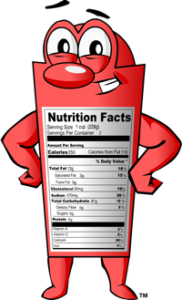
FDA’s Food Label Man
Entrepreneurs just getting started in the food industry are often shocked to learn how heavily regulated food labeling is. Here are the basics you need to know about the law pertaining to food labels.
1. Who regulates food labels in the US?
At the federal level, food labels are regulated by the US Department of Agriculture (USDA) (for meat, poultry and processed egg products), the Alcohol and Tobacco Tax and Trade Bureau (TTB) (for alcoholic beverages) and the Food and Drug Administration (FDA) (for all other foods). The Federal Trade Commission (FTC) has jurisdiction over advertising, including websites and social media marketing. States also have authority to regulate food labels and marketing.
2. Can you be sued for your labels?
YES! In the last few years, the plaintiffs’ bar has played an increasing role in “regulation” of food labels by bringing hundreds of class action lawsuits against food companies allegedly for deceiving consumers with false or misleading food labels. Foods labeled as “natural” that contain genetically modified, synthetic, or highly-processed ingredients have been the primary target of such lawsuits to date. The litigation has expanded to other types of labeling, including labeling that does not comply with FDA rules or otherwise is alleged to be misleading. Competitors also can sue for unfair competition based on a false or misleading food label.
3. What information must be on a food label?
All packaged foods must be labeled with: a statement of identity (the name or description of the food), the net quantity of contents, the identity and address of the manufacturer or distributor, an ingredients list, and allergen disclosure (if the food contains an allergen ingredient). Most packaged food labels also must have a nutrition label. There are rules about the content, placement and formatting of these required pieces of information.
4. What label claims may be made about health-related benefits of a food product?
It is flatly illegal to claim that a food product can help to treat, cure or mitigate any disease. Such claims may be made only for drugs, which must go through extensive review and approval by FDA before they may be sold. However, it is permissible to claim that a food product helps to support a normal, healthy bodily structure or function (such, as “supports a healthy immune system” or “builds strong bones”) provided that the manufacturer has sufficient scientific evidence to back up the claim.
FDA rules also set conditions for using the terms “healthy,” “health,” and other variants of those words, when used in connection with a claim about the nutrients or ingredients in the food. It is illegal to use those terms if the product contains too much fat, cholesterol or sodium, or if does not contain enough of at least one beneficial nutrient (vitamins A, C, calcium, iron, protein, or fiber).
5. What claims may be made about the nutrition content of food?
FDA regulations govern claims characterizing the level of a nutrient in a food product—for example, “high fiber” or “low fat.” Manufacturers may use only certain terminology in making such claims—such as, “good source,” “high,” and “excellent source.” You may not say that a product is “packed with vitamin C,” for instance. FDA regulations also define how much of each “bad” nutrient is too much for a “low” claim and what minimum amounts of “good” nutrients are needed for a “good source” or “high” claim. In some cases, a manufacturer may make a nutrient content claim only if it also includes an additional disclosure.
